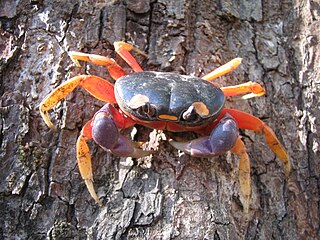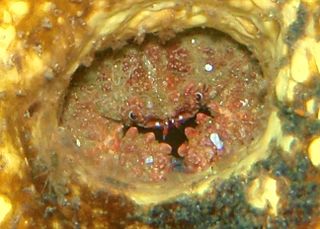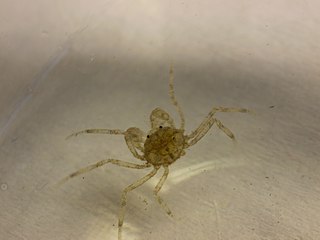
Gecarcinus quadratus, known as the red land crab, whitespot crab, Halloween crab, moon crab, Halloween moon crab, mouthless crab, or harlequin land crab, is a colourful land crab from the family Gecarcinidae.

The Ocypodidae are a family of semiterrestrial crabs that includes the ghost crabs and fiddler crabs. They are found on tropical and temperate shorelines around the world.

Tuerkayana hirtipes is a species of terrestrial crab.

Discoplax is a genus of terrestrial crabs. It is very closely related to the genus Cardisoma.

The Gecarcinidae, the land crabs, are a family of true crabs that are adapted for terrestrial existence. Similar to all other crabs, land crabs possess a series of gills. In addition, the part of the carapace covering the gills is inflated and equipped with blood vessels. These organs extract oxygen from the air, analogous to the vertebrate lungs. Adult land crabs are terrestrial, but visit the sea periodically, where they breed and their larvae develop. Land crabs are tropical omnivores which sometimes cause considerable damage to crops. Most land crabs have one of their claws larger than the other.

Gecarcinus is the type genus of the land crab family Gecarcinidae. They are found in warmer coastal regions of the Americas, including islands in the Caribbean. Four species from oceanic islands were formerly included in Gecarcinus as the subgenus Johngarthia, but are now treated as a separate genus, Johngarthia. While all members of this genus are largely terrestrial, they have to return to the ocean to breed. They are often colourful, with reddish, orange, purple, yellowish, whitish, or blackish being the dominating hues. This has resulted in some species, notably G. quadratus and G. lateralis, gaining a level of popularity in the pet trade.

Ocypode ceratophthalmus, the horned ghost crab or horn-eyed ghost crab, is a species of ghost crab. It lives in the Indo-Pacific region ; from the coast of East Africa to the Philippines and from Japan to the Great Barrier Reef. They also occur in the Pacific Islands to as far east as Polynesia and Clipperton Island. As their common name implies, O. ceratophthalmus possess eyestalks extending beyond the eyes into long points, which are longer in adults, and shorter in juveniles. The crabs have a box-shaped body, 6–8 centimetres (2.4–3.1 in) across the carapace, with a darker markings towards the rear in the shape of an H. The outer edges of the eye-sheaths are also sharp and broadly triangular and distinctly pointing sideways in larger individuals. O. ceratophthalmus can run at speeds of up to 2.1 metres per second (6.9 ft/s).

Karstarma is a genus of karst-dwelling crabs formerly included in Sesarmoides.

Johngarthia lagostoma is a species of terrestrial crab that lives on Ascension Island and three other islands in the South Atlantic. It grows to a carapace width of 110 mm (4.3 in) on Ascension Island, where it is the largest native land animal. It exists in two distinct colour morphs, one yellow and one purple, with few intermediates. The yellow morph dominates on Ascension Island, while the purple morph is more frequent on Rocas Atoll. The species differs from other Johngarthia species by the form of the third maxilliped.

Leucosiidae is a family of crabs containing three subfamilies and a number of genera incertae sedis:

Glyptoxanthus is a genus of crabs in the family Xanthidae, containing eight species. It was originally erected by Alphonse Milne-Edwards in 1879 for six species previously placed in the genus Actaea and elsewhere. Although previously included in subfamily Euxanthinae, the genus has a quite distinct morphology from other genera in that group, and was placed in 2011 in the new, monotypic subfamily, Glyptoxanthinae by Jose Christopher Mendoza and Danièle Guinot.

Johngarthia weileri is a species of land crab in the genus Johngarthia from the eastern Atlantic Ocean.

The Panopeidae are a family containing 26 genera of morphologically similar crabs, often known as "mud crabs". Their centers of diversity are the Atlantic Ocean and eastern Pacific Ocean.

Pilumnoides is a genus of crabs in the family Pilumnoididae. The genus was erected by Hippolyte Lucas in 1844. It contains the following species:

Gecarcinus nobili is a species of land crab closely related to the halloween moon crab. It was described in 2014. It is from the Neotropical Pacific coast of northwestern South America.

Johngarthia planata is a bright orange species of land crab that lives on inshore islands and the continental mainland coast of the tropical and subtropical Pacific coast of the Americas, including the Gulf of California, Costa Rica, Colombia, and continental mainland beaches of Mexico. The crabs are omnivorous and feed on seaweed (algae), vegetation and sometimes carrion.

Limnopilos naiyanetri, commonly referred to as the Thai micro crab or pill-box crab, is a freshwater hymenosomatid crab endemic to Thailand. Its presence has only been confirmed in the Tha Chin River. The species was described in 1991 and represents the type species of Limnopilos. The Thai micro crab was first introduced to the aquarium hobby in 2008 when it was imported to Germany by the tropical fish importer Aquarium Glaser GmbH, and has slowly grown in popularity with aquarium hobbyists. It remains a relatively rare species on the market and detailed information on the husbandry of this species is scarce.

Limnopilos is a genus of small hymenosomatid crabs endemic to Southeast Asia. The genus was described by Christina Chuang and Peter Ng in 1991, who identified the new species Limnopilos naiyanetri and distinguished it from the closely related genus Hymenicoides. Its true taxonomic classification was debated for several years, but in 2007 the discovery of a new species of crab in this genus solidified the distinction between Limnopilos and Hymenicoides. Many aspects of the genus Limnopilos are still poorly understood. Their ecology and natural history have not been studied in detail, and their reproductive cycle remains mysterious.

Tubuca dussumieri, is a species of fiddler crab that is found in the western and south pacific including New Caledonia, Indonesia, Malaysia, Taiwan, Japan, north eastern Australia

Johngarthia oceanica, also known as Clipperton crab, is a bright orange species of land crab that lives on Clipperton Island and on Socorro Island in the Revillagigedo Islands off Mexico in the tropical eastern Pacific. Prior to 2019, J. oceanica was considered part of J. planata, however a reexamination determined the land crabs on the oceanic islands to be a separate species. J. oceanica differs from J. planata in the shape of the mesial lobe of the infraorbital margin and the color of its carapace.
























